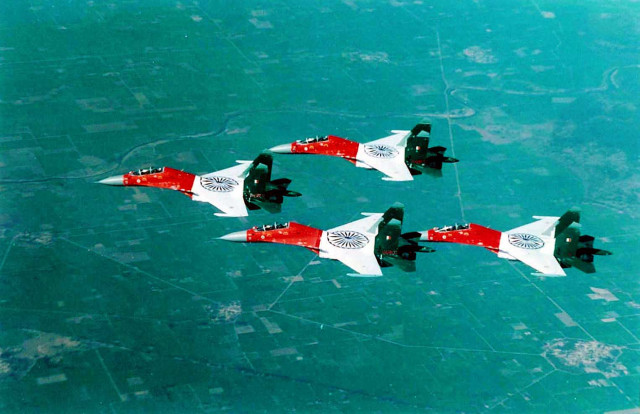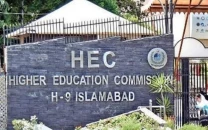India's ailing air force at risk as Pakistan, China modernise
India's deal with Rafale has stalled as both China and Pakistan ramp up fleet upgradations

Russian-made MiG and French Mirage fighters, along with more modern Russian Sukhoi Su-30s. But half of India's fighters are due to retire beginning this year until 2024. PHOTO: INDIANAIRFORCE.NIC.IN/FILE
A 2012 agreement to buy 126 Rafale fighters from France's Dassault Aviation has stalled due to a dispute over the assembly of the aircraft in India. India's first homegrown fighter, the Tejas light combat aircraft, will finally be delivered next month, 30 years after it was conceived.
But senior air force officers privately said they were unimpressed, with one former officer, an ex-fighter pilot, saying the plane was "so late it is obsolete".
While India's navy is undergoing an accelerated modernisation drive, experts said India was vulnerable in the skies because of its reliance on a disparate fleet of ageing Russian-made MiG and French Mirage fighters, along with more modern Russian Sukhoi Su-30s. But half of India's fighters are due to retire beginning this year until 2024.
"It could lead to humiliation at the hands of our neighbours," AK Sachdev, a retired air force officer, wrote last year in the Indian Defence Review journal. A coordinated attack by China and arch-rival Pakistan could stretch the Indian military, he added.
It's a scenario defence strategists in New Delhi have been asked to plan for, Indian air force sources say, although experts say such an event is highly unlikely to happen, primarily due to nuclear weapons owned by all three.
India's ties with China, though warm in recent times, are still hamstrung by a dispute over their Himalayan border that led to war in 1962. New Delhi is also wary of China's expanding naval presence in the Indian Ocean and its close relations with Pakistan.
Multiple crashes
India's air force has 34 operational squadrons, down from 39 earlier this decade and below the government approved strength of 42, a parliamentary committee said in December. In 2012, the then defence minister had said that more than half of India's MiG fighters had crashed and burned.
In this time, however, China has managed to project its military power, by exponentially ramping up its defence budget and boosting production capability in all areas, particularly aerial. It is flying locally built fourth-generation J-10 fighters and is testing two fifth-generation stealth fighter jets.
On the Western front, Pakistan is upgrading its Lockheed Martin F-16 fighters as well as using JF-17 warplanes developed with China. To replace and upgrade its fleet of ageing Mirages and F-7Ps, Pakistan is also in talks with China to buy J-10s.
But India still maintains an edge over Pakistan – the sheer size of its air force. But the slow modernisation means victory would come with heavy casualties, said Richard Aboulafia, Washington DC-based vice president of analysis at the Teal Group, an aerospace and defence think tank.
So far, India has bought more Su-30s and upgrading other existing fighters to keep itself in the game. Though keeping up may soon be no longer enough.
"We do need to increase our defence preparedness," Prime Minister Narendra Modi told the opening ceremony of the Aero India airshow in the city of Bengaluru on Wednesday.
Tejas criticism unfounded
K Tamilmani, a senior official at the Defence Research and Development Organisation (DRDO), a defence ministry agency which designed and developed the plane brushed aside criticism of the light aircraft.
"The Tejas has a safety record that is unbeaten," Tamilmani told Reuters by telephone, adding it would provide a platform to develop more advanced fighters in the years ahead. Indeed, with the amount of crashes that the Indian airforce has had to deal with, at least two since the start of the year, security it seems to weigh more heavily than being able to compete before more advanced and superior fighters.
Impasse over Rafale Jets
The Rafale fighters are expected to replace some of India's MiGs and Mirage fleet. But India is insisting Dassault take full responsibility for production of the aircraft at a state-run facility in Bengaluru, Indian defence ministry officials have said.
France, while agreeing to help Hindustan Aeronautics Ltd stick to delivery schedules, has shied away from offering guarantees for production of the aircraft made at a facility over which it has no administrative or expert control.
India would decide on the fate of the deal only after March, when a defence ministry committee delivers a report on the issue, Defence Minister Manohar Parrikar said at the airshow.
But cancellation of the multi-billion dollar deal would be "disastrous", said Deba Mohanty, chairman at Indicia Research & Advisory, a New Delhi-based defence consulting firm.
"It's a really tricky situation in which the supplier is unhappy, the bureaucrats are unhappy and the end user is disappointed," said Mohanty.
India has successfully introduced Boeing's C-17 cargo plane and P-8 Poseidon anti-submarine aircraft and Lockheed Martin's C-130J transport, all bought 'off the shelves', over the last few years. That shows off-the shelf solutions work best, experts said. But the Modi administration's "Make in India" programme, and the emphasis on building up a domestic defence industrial base to cut dependence on foreign supplies which make India the world's biggest arms importer, means the Rafale programme may not go as smoothly as hoped.
In this regard, the best hope for India is its Tejas Mark II, a slightly larger plane than the original, which will feature more powerful engines, better radars and upgraded avionics.
India is also looking to add trainer jets, light transport aircraft and helicopter to its list of indigenous defence programmes. "People who fly planes, want the best value for money, which means off-the-shelf," said Aboulafia. "People who want jobs and technology development schemes have different priorities. That's why the two groups don't like each other much."



















COMMENTS
Comments are moderated and generally will be posted if they are on-topic and not abusive.
For more information, please see our Comments FAQ